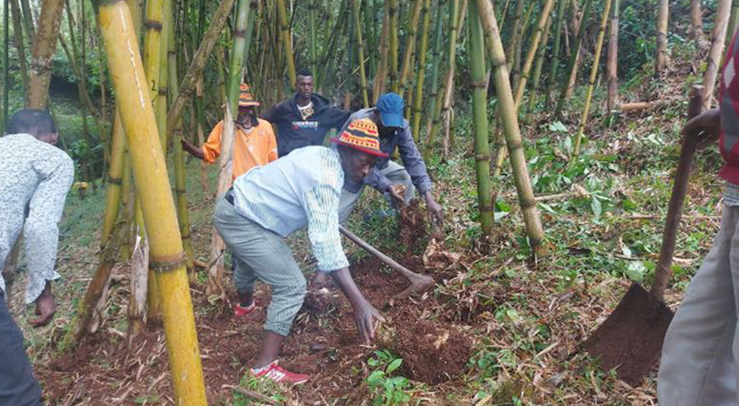Capacity building, Knowledge sharing and awareness raising on CBEMR with Stakeholders
This building block empowers local communities, government agencies, and other stakeholders with the knowledge, skills, and tools needed to implement and sustain effective mangrove restoration initiatives. Through strategic engagement and capacity-building efforts, stakeholders are equipped with the technical expertise and resources required for Community-Based Ecological Mangrove Restoration (CBEMR). These efforts include identifying and training CBEMR champions to act as catalysts for knowledge dissemination and practical restoration activities within their communities and institutions.
Wetlands International initiated capacity-building activities by engaging local communities in Lamu and Tana through CBOs, CFAs, and key government agencies, including KFS, KEFRI, KMFRI, the Lamu County Government, as well as CSOs such as WWF and the Northern Rangelands Trust. Women comprised 50% of the participants, taking a leading role in hands-on mangrove restoration efforts. Training sessions included sound restoration techniques based on the CBEMR approach, conducted in English and translated into Swahili for greater accessibility. These sessions integrated practical, relatable mangrove science with indigenous knowledge, fostering inclusivity and community ownership.
In addition, stakeholders were provided with simple tools such as refractometers and pH strips to conduct salinity and acidity tests, along with resources to support monitoring and adaptive management.
CBEMR champions, nominated from CFAs, BMUs, youth groups, women groups, and government agencies, further amplified these efforts. These champions assist in mobilising communities, raising awareness, conducting restoration activities, monitoring progress, and performing ecological and social assessments. Government agency champions also serve as Trainers of Trainers (ToTs) to ensure continuous capacity building within their institutions and communities.
Based on the success of the initial trainings in Lamu and other sites, Lamu KFS officials together with Wetlands International identified the need to spread this knowledge mainly at the policy and management levels within KFS among other key stakeholders. In partnership with KFS and MAP, we organised a CBEMR managerial training for the senior managers and coastal forest managers at KFS, Directors of Environment Department from the Kwale, Kilifi, Mombasa, Tana River, and Lamu counties, academia from Kenya School of Forestry and Kenyatta University, partner organisations in Global Mangrove Alliance namely IUCN, WWF and TNC, and representatives from the Western Indian Ocean Mangrove Network and local journalists with specialisation in environmental issues.
Collaboration with CSOs, the Global Mangrove Alliance, and other partners enhanced the initiative’s reach and impact, enabling regular training and knowledge-sharing activities across the mangrove regions.
Participatory and Holistic Approaches: CBEMR’s participatory design connects resource users with research institutions, local governments, conservation agencies, and civil society, leveraging their local and expert knowledge. This approach ensures holistic engagement and integration of diverse perspectives.
Strategic Selection and Empowerment of Champions: Champions were chosen based on leadership qualities, communication skills, and interest in mangrove conservation. Ensuring diverse representation, including women, youth, and community leaders, enhanced inclusivity. Champions were empowered with knowledge, skills, resources, and ongoing mentorship, ensuring effective community mobilisation and knowledge transfer. Clearly defined roles and responsibilities help to ensure that champions understand their contributions and can effectively advocate for mangrove conservation within their communities and agencies. Wetlands International helped create a system for communication and coordination, feedback mechanisms through regular meetings, and opportunities for knowledge sharing and joint problem-solving. Other than training, empowering champions has been key to the success of the initiative. This involves providing them with the necessary resources, including tools and financial support to ensure they can effectively carry out their tasks. Equally important is recognising and valuing their contributions, offering incentives that motivate them and providing opportunities for personal and professional growth. This approach not only strengthens their commitment but also inspires others to actively participate in mangrove conservation efforts.
Strong Partnerships: Collaboration between Wetlands International, KFS, KEFRI, KMFRI, local communities, and CSOs facilitated effective knowledge sharing, resource mobilisation, and policy influence.
Gender Roles and Social Groupings: Recognising women’s central role in mangrove restoration activities and the relatively well-established CBOs in Lamu fostered greater engagement and ownership among stakeholders. Gender-sensitive planning ensured that initiatives were inclusive and impactful.
Access to Information and Resources: Training materials in English and Swahili, simple-to-use tools, and practical workshops enhanced knowledge transfer, enabling stakeholders to implement CBEMR effectively.
Supportive Policy Environment: Training efforts influenced KFS and other government agencies to integrate CBEMR principles into national guidelines and management strategies, fostering a conducive policy framework for sustainable mangrove restoration. Working with KFS and KEFRI on the use and application of the CBEMR approach provided for review of the national restoration guidelines which take into consideration the information on CBEMR.
Adaptive Management Approach: Regular monitoring of restoration activities allowed stakeholders to adapt strategies, learn from experiences, and improve outcomes over time, ensuring long-term success.
Knowledge Sharing is Critical: Disseminating information and best practices in local languages ensures inclusivity, promoting wider adoption of the CBEMR approach. Making information accessible facilitates understanding, contribution, and participation across diverse communities.
Champions are Powerful Agents of Change: Investing in targeted champions with influence and networks amplifies the reach and impact of mangrove restoration efforts. Empowering them with skills, resources, and incentives strengthens their commitment and inspires broader community engagement.
Diversity and Representation Matter: Selecting champions from diverse backgrounds ensures that restoration initiatives are inclusive and responsive to varying community needs.
Collaboration Enhances Effectiveness: Facilitating collaboration among champions and stakeholders promotes cross-learning, knowledge sharing, and collective action, boosting the effectiveness of restoration efforts.
Policies Must Be Adaptive: Flexible policies informed by monitoring data and lessons learned are essential for addressing emerging challenges and improving restoration practices. For this National-level forest managers should be engaged in local and sub-national based restoration initiatives to aid in the development of mangrove forest policies. For instance, based on the success of the first CBEMR training in Lamu, area KFS officers identified the need to spread this knowledge to the KFS managerial team and senior policy-level managers, and other key stakeholders.
Empowerment Drives Success: Providing champions with tools, financial support, and opportunities for personal and professional growth inspires commitment and fosters sustainable community-driven conservation.
